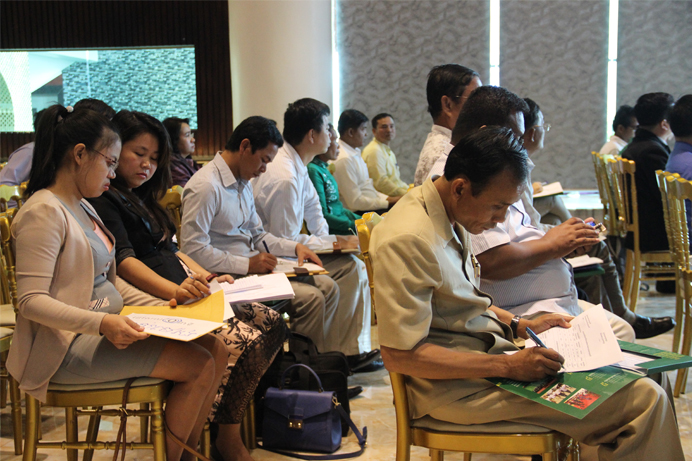
Phnom Penh, September 22, 2015: This morning, the report on “Statistic Analysis on Land Dispute in Cambodia, 2014”, initiated by NGO Forum on Cambodia (NGOF) is officially launched to the public at Tonle Bassac 2 Restaurant. Approximately 60 participants from the National Assembly, Mondolkiri’s Deputy Governor, Ministry of Land Management Urban Planning and Construction, local authorities in Phnom Penh, development partners, local and international NGOs network/members and communities attended this event.
This event is organized in order to publicly disseminate the report result, present key findings of the report to public and lastly, to increase knowledge and understanding of land situations in order to bring all relevant stakeholders to pay attention on them and further spread out to call for intervention.
Dr. Tek Vannara, NGOF’s Executive Director shared that land disputes in Cambodia are widely seen as one of the biggest challenges facing the Cambodian people and also represent a significant challenge to Cambodia’s reputation in the international arena at which it is inconsistent with the Royal Government of Cambodia (RGC) achieving its poverty reduction goals. “As records in the database of NGOF indicates that some land dispute cases in Cambodia have been on-going for a number of years and caused by many factors including infrastructure development projects in urban and rural areas, economic land concessions (ELCs), other concessions operated by national and international companies and land grabbing by individuals,” he added.
In response to settlement of these issues, many mechanisms and approaches have been made by the RGC such as Commune Councils, Cadastral Commission, Administrative Commissions, and National Authority for Land Dispute Resolutions. As a result, various institutions or working group have been formed. However, the impacts of these approaches and interventions through the results of the land dispute resolution processes have not been reported consistently across all stakeholders.
“I am asking the government to urgently solving the problems for my family and community because we are not living in a very difficult situation in term of livelihood opportunity and the infrastructure from this development project,” said Ms. Yong Ran, a Community Representative from Sangkom Thmey case, Pursat Province. “We also hope our government to practice the leopard-skin policy on our land area, so we have a place to live and to do our agriculture work.”
A report of the Annual Statistical Analysis on Land Dispute in Cambodia 2014 has been developed by following the methodology such as;
- Land Dispute Cases Identification Criteria. Land dispute cases involving 5 households (HHs) or more; Land dispute cases that have not yet been resolved or are only partially resolved; and Land dispute cases that were solved before the year 2013 are excluded from this analysis. However, cases that were resolved during the course of 2014 are included.
- Data Collection and Updating Data on Land Disputes. The information collection and data updating system of RACC are: Daily collection of information on land dispute cases is conducted through monitoring of local media (including the Phnom Penh Post, Radio Free Asia, The Cambodia Daily, Koh Santepheap and Raksmey Kampuchea). Moreover, it gathers the information from provincial LAHRiN members via bi-monthly network meetings that the media were not reported. This meeting provides a chance to conduct verification on Land Dispute Cases.
The online report on “Statistic Analysis on Land Dispute in Cambodia, 2014” can be downloaded here:
1. Khmer version http://bit.ly/1Mgenru
2. English version http://bit.ly/1Fkr1pv
